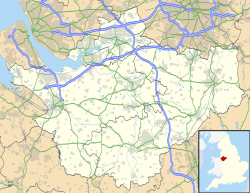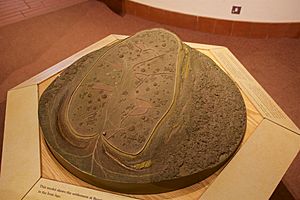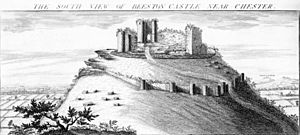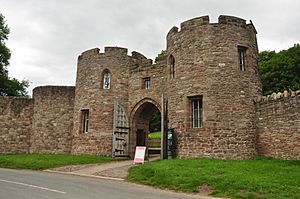Beeston Castle facts for kids
Quick facts for kids Beeston Castle |
|||||||||||||||||||||||||||||||||
|---|---|---|---|---|---|---|---|---|---|---|---|---|---|---|---|---|---|---|---|---|---|---|---|---|---|---|---|---|---|---|---|---|---|
| Part of Cheshire | |||||||||||||||||||||||||||||||||
| Beeston, England | |||||||||||||||||||||||||||||||||

A modern bridge provides access to the gateway of the inner ward.
|
|||||||||||||||||||||||||||||||||
|
|||||||||||||||||||||||||||||||||
Beeston Castle is an old royal castle in Beeston, Cheshire, England. It sits on a tall, rocky sandstone hill about 110 meters (350 feet) above the Cheshire Plain. Ranulf de Blondeville, 6th Earl of Chester, a powerful leader, built it in the 1220s after he came back from the Crusades.
In 1237, King Henry III took over Beeston Castle. It was kept in good shape until the 1500s, when people thought it was no longer needed for fighting. However, it was used again in 1643 during the English Civil War. The castle was partly pulled down in 1646. This was ordered by Oliver Cromwell to stop anyone from using it as a fort again. In the 1700s, parts of the castle grounds were used as a quarry to dig out stone.
Today, English Heritage owns and manages the castle. It is a Scheduled Ancient Monument, which means it's an important historical site. The walls of the outer part of the castle and the gatehouse are also protected as Grade I listed buildings. There's a legend that King Richard II buried royal treasure here, but no one has ever found it.
Contents
Beeston Castle: A Hilltop Fortress
Where is Beeston Castle?
Beeston Castle is built on Beeston Crag. This crag is part of the Mid Cheshire Ridge. This ridge is a line of low sandstone hills. It stretches from the River Mersey down to the middle of the Cheshire Plain. The flat area between the northern and southern parts of the ridge is called the Beeston Gap. This gap was formed by melting ice at the end of the Ice age.
The hill is made of layers of Triassic sandstone. The lower parts are from the Wilmslow Sandstone Formation. The upper parts are from the Helsby Sandstone Formation, which is about 245 million years old. The very top of the hill has a small bit of Tarporley Siltstone Formation. Both types of sandstone were once dug out from quarries inside the castle grounds.
On the east side of the hill is the Peckforton Fault. This is a big crack in the earth that causes the ground to drop to the east. A low ridge of rocky material from a glacier is also found east of the castle. This shows where a large ice sheet stopped moving during the last ice age.
Life Before the Castle: Prehistory
People lived or gathered at the Beeston Castle site as far back as 4,000 BC. This was during the Neolithic period (New Stone Age). Archaeologists have found old flint arrowheads from this time. They also found signs of a Bronze Age community. There was even an Iron Age hill fort here.
The earth wall from the Bronze Age was built around 1270–830 BC. Seven round buildings were found that were from either the late Bronze Age or early Iron Age. It might have been a special place where people worked with metal.
Building and Royal Ownership
How Beeston Castle Was Built
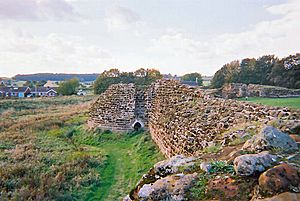
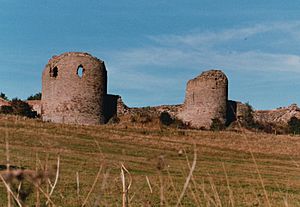
Ranulf de Blondeville built Beeston Castle in the early 1200s. The builders used the old walls from the Iron Age hill fort for the castle's outer defenses. In old papers, the castle was called Castellum de Rupe, which means "Castle on the Rock."
Beeston is one of three big castles Ranulf built around the 1220s. He built them after returning from the Fifth Crusade. The other two are Bolingbroke in Lincolnshire and Chartley in Staffordshire. They all have similar designs, especially their towers.
Unlike many castles of its time, Beeston does not have a central tower called a keep. Instead, the castle used the natural shape of the land. It had very strong walls, powerful gatehouses, and carefully placed towers. These features made the castle's main areas (called baileys) the strongest parts.
The castle had two main parts:
- First, a rectangular castle on the very top of the hill. It had steep drops on three sides. On the fourth side, a deep ditch, up to 9 meters (30 feet) deep, was cut into the rock.
- Second, an outer bailey was built on the lower slopes. This part had a huge gatehouse. It was protected by a ditch that was 5 meters (16 feet) wide and 3 meters (10 feet) deep.
The outer bailey was mostly rectangular. Its walls were 2 meters (6 feet) thick. They were made of sandstone on the outside and filled with rubble inside. These walls, some of which are still standing, had D-shaped towers. These towers were a new idea for English castles back then. They let defenders shoot sideways along the walls, not just straight ahead. Their open backs meant that if attackers got inside, the towers wouldn't give them cover. The inner bailey was on the rocky top at the west end of the hill.
To make sure the castle had fresh water, two wells were dug into the rock. One of them is 113 meters (370 feet) deep. It is one of the deepest castle wells in England.
Beeston as a Royal Castle
Most of the castle's defenses were ready when Ranulf died in 1232. But there were no living quarters built yet. When Ranulf's successor, John, died in 1237, there were still no proper homes inside. John had no son, so King Henry III took over the area of Cheshire.
King Henry made Beeston Castle bigger during his wars with Wales. He used it as a prison for Welsh captives. No permanent homes like halls or rooms were built. Soldiers likely lived in wooden buildings within the outer bailey.
In 1254, Henry gave Beeston and other lands in Cheshire to his son, Prince Edward. He also gave Edward the title Earl of Chester. This title has been given to the heir to the English throne ever since. In 1265, the castle was briefly taken by a group against the King. But it was soon taken back by royal supporters. Edward became King of England in 1272. He finished conquering Wales.
In the mid-1300s, there are records of men from Cheshire who were made constables of the royal castle. The constable was like the castle's manager. They probably lived in or near the gatehouse. In 1593, someone described the castle as having "a goodly strong gatehouse, and strong wall with other buildings." They said these buildings were "a convenient habitation for any great personage."
Beeston was kept in good repair and improved during Edward's time and throughout the 1300s. But by the 1500s, the English Crown no longer needed the castle. In 1602, it was sold to Sir Hugh Beeston.
There have long been stories about treasure hidden by King Richard II somewhere in the castle grounds. The story says Richard hid some of his wealth at Beeston in 1399. This was before he went to Ireland to stop a rebellion. When he came back, Richard was removed from power by Henry, Duke of Lancaster (who became King Henry IV). The treasure is said to have stayed hidden. Many searches have been done, mostly in the deep well in the inner bailey, but nothing has ever been found. The rumor might not be true, as King Henry IV is recorded as having found Richard's gold and jewels from their hiding places.
The English Civil War
During the English Civil War, many old castles that had been forgotten were used again. Parliamentary forces took Beeston on February 20, 1643. They were led by Sir William Brereton. The castle walls were fixed, and the ditch was cleaned out.
Later in 1643, part of the royal army from Ireland landed at Chester. On December 13, 1643, Captain Thomas Sandford and eight soldiers from that army snuck into Beeston at night. They might have been helped by someone inside. They surprised the castle's leader, Captain Thomas Steele. He was so shocked that he gave up the castle. He was allowed to leave with his soldiers. Steele was later put on trial and shot for not holding the castle.
The Royalists were under siege by parliamentary forces from November 1644 to November 1645. They ran out of food and had to surrender. The castle was partly destroyed in 1646. This was done to stop anyone from using it as a stronghold again.
Later Years and Preservation
People dug for stone in the castle grounds during the 1700s. The gatehouse leading into the outer bailey was pulled down. This was done to build a path for the stones to be taken away.
In 1840, John Tollemache, 1st Baron Tollemache bought the castle. He was the biggest landowner in Cheshire at that time. In the mid-1800s, the castle hosted a yearly two-day festival. This event raised money for local widows and orphans. It attracted more than 3,000 visitors each day.
Preserving Beeston Castle
The castle is now owned by English Heritage. Even though it is in ruins, enough of the walls and towers remain. They give a clear idea of how it looked when it was new. The castle is open to visitors. It has a small museum and a visitor's center.
A lodge house was built by Tollemache in the 1800s. It was made bigger in the 1900s. This lodge is two stories high. It has two round towers on either side of a central archway. It is protected as a Grade II listed building.
The views from Beeston Castle are amazing. You can see across eight counties. From the Pennines mountains in the east to the Welsh mountains in the west.
See also
 In Spanish: Castillo de Beeston para niños
In Spanish: Castillo de Beeston para niños


